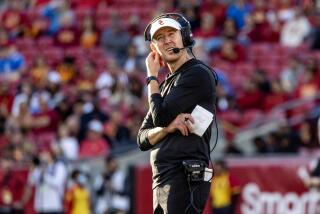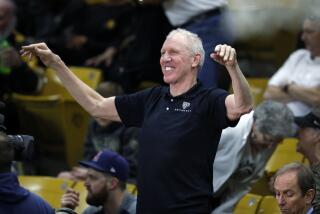The Sham of College Athletics ....
On Jan. 1, 1965, I watched on television as Tommy Nobis and the Texas Longhorn defense “screwed their navels to the ground,” as their colorful down-home coach, Darrell Royal, would say later, in a fourth-quarter goal-line stand that preserved a 21-17 victory over Joe Namath and the Alabama Crimson Tide in the Orange Bowl. The ‘Horns had hooked me.
Although I was not yet out of junior high school in a small East Texas town, I decided that night that I someday would attend the University of Texas and share the collegiate experience of those young men who represented our state so valiantly. Upon learning a few years later that the university also was solid academically, I considered that a bonus. Nothing more.
Some time after arriving in Austin, I got my priorities straight, or at least straighter, which is more than can be said for the university in respect to its sports, particularly football. Not only did the average students at Texas not share the collegiate experience with the football players, we rarely even saw them outside Memorial Stadium on fall Saturdays.
Unlike players at some universities who are confined to athletic dorms, our Longhorns at least lived in the vicinity of other students in Jester Center, the massive dormitory featured in Aaron Latham’s Esquire article that inspired the movie “Animal House.” But the players had their own floors, their own cafeteria and, presumably, their own food fights.
Many also attended the same classes, which were recommended to them by an academic counselor (“brain coach”) and usually had in common professors who were friendly to the athletic department and gave players grades necessary to maintain their eligibility. Too often, it seemed as if there were no more connection between academics and football as there is between the Red River and the Red Sea.
Later, as my sportswriting career bounced me from the Southwest to the Midwest, the East Coast and, eventually, the West Coast, I discovered what I had cynically suspected as an undergraduate: The situation at Texas was not an exception but the rule among our nation’s football factories.
So as I watch the Longhorns play the Miami Hurricanes on this Jan. 1 in the Cotton Bowl, I will be fully aware that what I am seeing in that game, as well as in the other post-season bowl games, is semi-pro football. About the only connection the teams have to the universities they represent is those high-minded commercials aired during games that tout the academic wizardry occurring on the respective campuses. How else would one find out about the terrific medical school at the University of Arkansas unless he watched the Hogs play on television?
Unfortunately, the National Collegiate Athletic Assn. (NCAA), which governs major-college sports, and the news media have concentrated in recent years on what illegal inducements the players in revenue-producing sports such as football and basketball are getting--under-the-table payments, cars, cushy summer jobs, T-shirts--instead of what they’re not getting: educations.
Fortunately, the publishing houses have not ignored this fraud, as evidenced most recently by the publication of two books--Francis X. Dealy Jr.’s “Win at Any Cost: The Sell-Out of College Athletics” and Murray Sperber’s “College Sports Inc.: The Athletic Department Vs. the University.”
As Dealy discovered in his research, this is hardly a new phenomenon. In 1898, Brown University called together representatives from the elite Eastern universities that now form the Ivy League, which played higher-quality football than any professional football league that existed at the time, to discuss the role of athletics on campuses.
The subsequent Brown Conference report suggested a number of reforms, including one that would allow teams to use only players who were in good academic standing. But the report was largely ignored. Unwilling to disarm unilaterally, Harvard refused to accept any limitations that were not adopted by Yale. Yale--whose coach, Walter Camp, practically invented football as we know it today--did not even send a representative to the conference.
The Ivy League eventually reformed, but it is an island among major athletic conferences. The precedent for big-time college sports was established. As Dealy and Sperber conclude after exploring the subject in considerable depth, it is less accurate today to refer to student-athletes than to athlete-students. In some cases, even that is too charitable.
For instance, both Dealy and Sperber write about Andrew Gaze, a basketball sharpshooter who enrolled at Seton Hall at age 23 in October of 1988. Gaze played for one season, during which the Pirates advanced to the NCAA finals in March, 1989; then he returned home to Australia to play professionally. Student-athlete? Try mercenary.
The books are filled with examples of abuses in college athletics today, although Dealy also includes a revealing history lesson concerning the formation of the NCAA. As a sports reporter who has had more than a passing interest in this subject for 20 years, even I was surprised by some of the myths exposed by Sperber regarding the business of athletic departments. It is difficult after reading these books to conclude that big-time college sports is anything other than a lie.
But it is a third book--”Backboards & Blackboards: College Athletics and Role Engulfment”--that proves most enlightening because it is written from inside a major college’s athletic department. Sperber is an English and American studies professor at Indiana University, but he, like Dealy, deals generally with the abuses of college athletics.
Sociologists Patricia and Peter Adler, on the other hand, concentrated on the basketball program at Tulsa University, although their book also drew from experiences with athletic departments at five universities in three cities over 10 years. As academic counselor to the basketball players at Tulsa in the early 1980s, Peter Adler had access to what he calls the team’s “black box.”
As expected from an academic project, the Adlers conducted their research scientifically and, by all appearances, objectively. They not only liked and respected the head basketball coach, Nolan Richardson (who since has moved to Arkansas), they dedicated the book to him. Yet it is their book, oddly enough, that is the most damning of college athletics.
From the Adlers’ observations, it is apparent that things did not change much on campuses in the decade after I left Texas. There was little effort at Tulsa to integrate the mostly black basketball players into the overwhelmingly white student body, as they were restricted to an athletic dorm that the Adlers described as a “ghetto.” Aside from the racial differences, their day-to-day existence was so different from that of average students that most players did not even feel comfortable socializing with non-athletes. The athletes felt isolated, seeing themselves not as students but as “quasi-employees” of the university.
That is a small price to pay for an education; unfortunately, too many athletes in the major sports do not receive the educations they are promised while being recruited out of high schools by coaches. While NCAA statistics show that athletes in general graduate at about the same rate as non-athletes, athletes in the revenue-producing sports--football and basketball--for major college programs do not fare nearly as well in classrooms. The graduation rates for black athletes in big-time college sports are so depressingly low--26.1% in football and 17.1% in basketball--that University of California, Berkeley sociologist Harry Edwards refers to them as “black gladiators.”
The Adlers concluded that some of the basketball players at Tulsa were victimized, but they also viewed Richardson as a victim of a high-pressure win-or-be-gone system. They portrayed him as a conscientious man who put a premium on education while recruiting athletes but, in the heat of a season, allowed his commitment to that end slide. Even some of the athletes who received their degrees told the Adlers that they felt used.
In a much-publicized 1988 court case that was recounted in Dealy’s book, Ronnie Harmon, a former running back for the University of Iowa, testified that he failed to graduate because the athletic department’s academic counselor allowed the athlete to take simple courses unrelated to his major so that he could remain eligible to play football. Among his courses were watercolor painting, billiards, slo-pitch softball, recreational leisure and ancient athletics.
Harmon was lucky. He has succeeded in professional football. But he is an exception. Of major-college football and basketball players, only about 1% reap the fame and fortune of professional sports.
When I take time to think about this subject, I become angry, certainly more angry than when I read that some athlete at Missouri or Illinois or Nevada-Las Vegas has received a little pocket change from a booster.
I have to confess, however, that college football still entertains me. Come Jan. 1, I will screw my navel to the television and watch the Texas Longhorns play the Miami Hurricanes. Of course, I know now that the outcome of the game does not reflect on the quality of the universities. Besides, Miami probably will win. But let’s meet again at the GE College Bowl. We’d kill ‘em.
More to Read
Go beyond the scoreboard
Get the latest on L.A.'s teams in the daily Sports Report newsletter.
You may occasionally receive promotional content from the Los Angeles Times.










